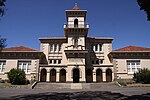Kardinia Park (stadium)
A-League Men stadiumsA-League Women stadiumsAFL Women's groundsAustralian Football League groundsBuildings and structures in Geelong ... and 11 more
Cricket grounds in AustraliaGeelong Football ClubRugby league stadiums in AustraliaRugby union stadiums in AustraliaSoccer venues in Victoria (state)Sport in GeelongSports venues completed in 1941Sports venues in Victoria (state)Use Australian English from July 2011Victorian Football League groundsWestern United FC

Kardinia Park (also known as GMHBA Stadium due to naming rights) is a sporting and entertainment venue located within Kardinia Park, South Geelong, in the Australian state of Victoria. The stadium, which is owned and operated by the Kardinia Park Stadium Trust, is the home ground of AFL club Geelong Football Club. Kardinia Park can accommodate 40,000 spectators, making it the largest-capacity Australian stadium in a regional city.
Excerpt from the Wikipedia article Kardinia Park (stadium) (License: CC BY-SA 3.0, Authors, Images).Kardinia Park (stadium)
Moorabool Street, Geelong South Geelong
Geographical coordinates (GPS) Address Nearby Places Show on map
Geographical coordinates (GPS)
| Latitude | Longitude |
|---|---|
| N -38.158055555556 ° | E 144.35472222222 ° |
Address
GMHBA Stadium
Moorabool Street
3220 Geelong, South Geelong
Victoria, Australia
Open on Google Maps









